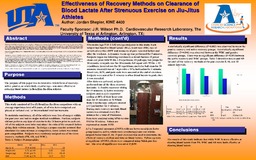
ATTENTION: The works hosted here are being migrated to a new repository that will consolidate resources, improve discoverability, and better show UTA's research impact on the global community. We will update authors as the migration progresses. Please see MavMatrix for more information.
Show simple item record
| dc.contributor.author | Shepler, Jordan | |
| dc.date.accessioned | 2017-07-11T23:00:08Z | |
| dc.date.available | 2017-07-11T23:00:08Z | |
| dc.date.issued | 2016 | |
| dc.identifier.uri | http://hdl.handle.net/10106/26874 | |
| dc.description | KINE 4400 | en_US |
| dc.description.abstract | Introduction: Blood lactate is one of the most measured parameters during performance testing of athletes. With high intensity training comes an increased level of blood lactate. If not properly cleared, elevated blood lactate levels are associated with impaired muscle function as well as reduced exercise performance. Previous studies have demonstrated that active recovery (AR), performing low intensity aerobic exercise post exercise is more effective at clearing lactate than rest/ passive recovery (PR). Whole-body Cryotherapy (WBC) has recently gained popularity for improving recovery after strenuous exercise as an alternative to traditional ice-water therapy. Subjects enter a specially designed cabin in which liquid nitrogen lowers the temperature of the air (-110 to -140C) for a short period of time, usually 3 minutes.
Purpose: The purpose of this paper was to determine which form of recovery--active, passive, or whole-body cryotherapy--was most effective at reducing blood lactate in Brazilian Jiu-Jitsu Athletes.
Methods: Five males (age 37.8 ±3.82 yrs.) participated in this study. Each subject had baseline blood lactate (BLa), heart rate (HR), rate of perceived exertion (RPE and measures of pain recorded before and after the workout. A dynamic warm-up was performed for 5 minutes. Subjects began the following exercises in a circuit fashion: 8 power clean and press with 95 lbs. x 8 repetitions; 10 pull-ups; box jumps for 30 seconds; renegade row for 30 seconds; full squat with 95 lbs. x 10 repetitions; inverted row for 10 repetitions; medicine ball slam for 30 seconds; treadmill run at 7 mph with a 15% inclination for 1 minute. Heart rate, RPE, and pain scale were assessed at the end of exercises. Subjects were seated for 5 minutes to allow blood lactate to peak, then it was recorded. After data was gathered, subjects performed one of the three recovery methods: 1) Passive recovery-sitting for 15 minutes; 2) Active recovery-subjects used a cycle ergometer cycling at 40% of their heart rate max for 15 minutes; or 3) Whole Body Cryotherapy-subjects entered a Cryochamber for 3 minutes. During each recovery method, blood lactate was obtained every five minutes for a total of 15minutes.
Results: A statistical significant difference (P=0.003) was observed between the passive recovery and active recovery groups. A statistical significant difference (P=0.001) was observed between the WBC and passive recovery groups. There was no significant difference (P>0.05) between the active recovery and WBC groups.
Conclusion: The results of this study indicate that while WBC is more effective at clearing blood lactate than PR, WBC and AR were both effective at clearing blood lactate. | en_US |
| dc.description.sponsorship | Wilson, J.R. | en_US |
| dc.language.iso | en_US | en_US |
| dc.subject | athletes | en_US |
| dc.subject | Jiu-jitsu | en_US |
| dc.subject | Blood lactate | en_US |
| dc.subject | Cryotherapy | en_US |
| dc.title | Effectiveness of Recovery Methods on Clearance of Blood Lactate After Strenuous Exercise on Jiu-Jitus Athletes | en_US |
| dc.title.alternative | Effectiveness of Recovery Methods on Clearance of Blood Lactate After Strenuous Exercise on Jiu-Jitsu Athletes | en_US |
| dc.type | Presentation | en_US |
| dc.publisher.department | Department of Kinesiology, The University of Texas at Arlington | en_US |
| dc.publisher.department | Cardiovascular Research Laboratory, The University of Texas at Arlington | en_US |
| dc.publisher.department | Exercise Science Research Laboratories, The University of Texas at Arlington | en_US |
Files in this item
- Name:
- Shepler.pdf
- Size:
- 1.077Mb
- Format:
- PDF
This item appears in the following Collection(s)
Show simple item record


